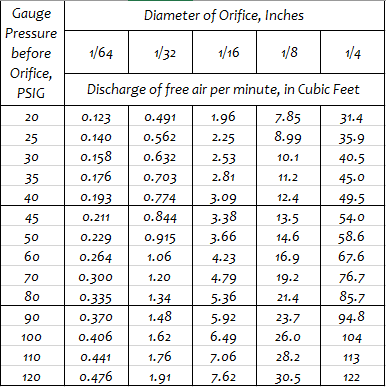Discharge of Air Through an Orifice
by bsbergmann
|
My Application Engineer colleagues and I frequently use a handy
table, called Discharge of Air Through an Orifice. It is a useful tool to
estimate the air flow through an orifice, a leak in a compressed air system, or
through a drilled pipe (a series of orifices.) Various tables and online
calculators are available. As an engineer, I always want to know the 'science'
behind such tables, so I can best utilize the data in the manner it was
intended.

The table is frequently found with values for pressures less
than 20 PSI gauge pressure, and those values follow the standard adiabatic
formula and will not be reviewed here. The higher air pressures typically
found in compressed air operations are of interest to us.
For air pressures above 15 PSI gauge the discharge is calculated
using by the approximate formula as proposed by S.A. Moss. The earliest
reference to the work of S.A. Moss goes back to a paper from 1906. The
equation for use in this table is-

Where:

For the numbers published in the table above, the values were
set as follows-
C
= 1.0, p1
= gauge pressure + 14.7 lbs/sq. in, and T1 =
530 °R (same as 70 °F)
The equation calculates the weight of air in lbs per second, and
if we divide the result by 0.07494 lbs / cu ft (the density of dry air at 70°F
and 14.7 lbs / sq. in. absolute atmospheric pressure) and then multiply by 60
seconds, we get the useful rate of Cubic Feet per Minute.
The table is based on 100% coefficient of flow (C = 1.0) For
well rounded orifices, the use of C
= 0.97 is recommended, and for very sharp edges, a value of C = 0.61 can be used.
The table is a handy tool, and an example of how we use it would
be to compare the compressed air consumption of a customer configured drilled
pipe in comparison to that of the EXAIR Super Air Knife.
Please check out the blog written
recently covering an example of this process.
If you would like to talk about the discharge of air through an
orifice or any of the EXAIR Intelligent
Compressed Air® Products, feel free to contact EXAIR
Comentários
Enviar um comentário